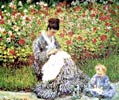Other paintings with similar compositions

Madame Monet and child
With all this in mind - let
us start with a painting from 1875: ‘Mme
Monet and child’, 55x66, (W 382). The scene is much the
same. She is sitting turned against us in the same way. The
‘outline’ of the skirt goes directly to her eyes. The child plays
the same part as the table in our painting, giving balance to the
composition. If we cover them up with a piece of paper, we
understand their importance. Our eyes cannot focus on anything, and
will start to wander about.
Before leaving this painting we simply have to check the central
point of it – could it possibly be the needle that is the very heart
and focus? Yes it is – exactly! Again we notice: Nothing was left to
accident in the Monet laboratory…

Camille au métier
The next painting: ‘Camille
au métier’, (W.366, 65x55, The Barnes Foundation of Art,
Pennsylvania), is even more close to our 'Au Métier'-scene.
We see Camille from the same angle. The ‘outlines’ are similar. In
addition, we even have the oval shape of our garden table, that we
recognise in the flower pot. Compare also the leaves and the
branches behind her. In this painting we find the needle
exactly in the centre vertical line but above the horizontal.
In these paintings we have another exciting
detail to study.
|

Click
HERE for a comparison of reflected light.

Click
HERE for a macro-zoom of Suzanne's hair.
Please observe the damages in the paint surface. The painting
was taken down from the stretcher and folded.

Click
HERE for a color comparison. |
In the two paintings with Alice Hoschedé in the
garden, (W.680 & 681), we find the same table! Here the leg of the
table creates a line together with her hands towards her eyes. In
the first version to the right, (W.681), there is no cloth on the
table. In the second, a cloth has appeared, just like in our
painting. The chair she is sitting on is nearly invisible. Instead
we have the trunk creating a curve, and a stop for our eyes, to slip
out over the left edge. It plays the same part as the curve of the
chair, and the branches in our ‘Garden scene’.
Press HERE for next page
|